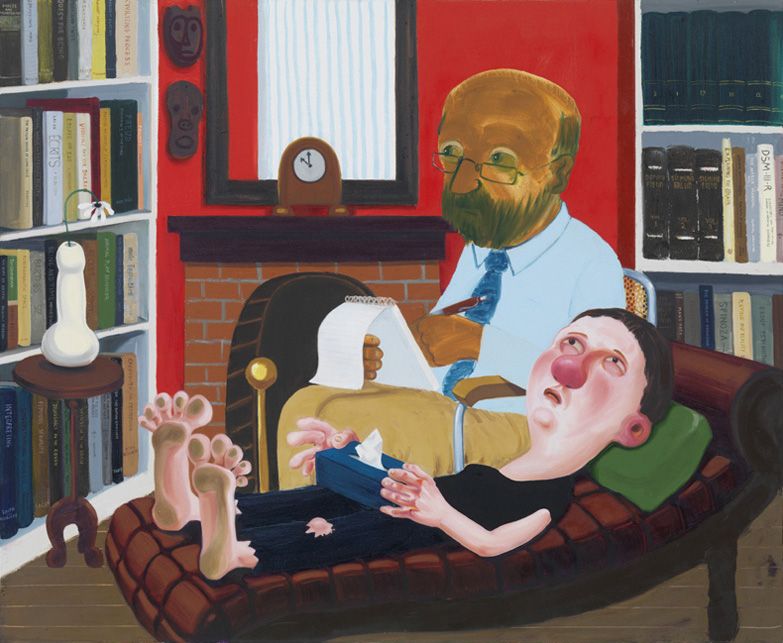
Nicole Eisenman ‘The Session’
Julie Mehretu – They Departed For Their Own Country Another Way (a 9x9x9 hauntology)[03.11.2023] @ White Cube
A series of giant paintings, vibrant and dynamic. Mehretu uses an impressive layering technique. It took a while to realize they’re paint and canvas and not multiple layers of frosted glass. The style is redolent of Kandinsky. In the accompanying description there is reference to power asymmetries, war and displacement. But at least for this (admitted) outsider it is difficult to connect these themes in the abstract images. It sounds harsh, but I kept on thinking: this is the type of stuff that you expect to see in the lobby of the headquarters of a giant bank.
Nicole Eisenman – What Happened [12.11.2023] @ Whitechapel Gallery
A fine retrospective on Eisenman’s work. The space is arranged chronologically so we see the transformation of her practice over time. I was particularly enamoured with some of the earlier paintings like The Session (2008) and the Triumph of Poverty (2009). All her work exudes dark humour on themes ranging from patriarchy to inequality to mental health to digital technology. The kinetic installation Maker’s Muck (2022) serves as a crescendo for the exhibition, displaying the versatility and playfulness of an artist attuned to the absurdities of life in contemporary capitalism.
Batushka w/ Kanonenfieber [16.11.2023] @ The Dome
Will the real Batushka please stand up? I saw them at The Dome back in February, and was so impressed, I decided to take a second look. But apparently the Batushka I saw earlier this year is the fake Batushka and the one I just saw is the real deal. I haven’t dug too deeply into the Batushka schism, but what little I’ve read online (or saw on Youtube) suggests there’s an intriguing story here about battles over creativity, intellectual property and authenticity. For a political economist more into the metal scene than me: there’s an article there!
Anyway, I missed the first band, getting there just in time for the start of Kanonenfieber’s set. I’ve seen a lot of strange musical performances in my time but this ranks as one of the most bizarre. They are a World War One-themed melodic black/death metal outfit from Germany. All live music is a form of theatre, but Kanonenfieber takes the theatrical element to new heights. Their set is divided into roughly five acts. For each act the band dons different WWI outfits. At the start the singer is wearing a military outfit, replete with Kaiser Wilhelm helmet, making aggressive gestures commanding to the audience get into it. It’s definitely not an energy I can connect with, and it got my anti-fascist senses tingling. When I got home I was relieved to find out that they rank as “not sketchy” according to those in the know on black metal politics. Apparently Kanonenfieber have openly expressed anti-Nazi views on social media.
The experience made me reflect: why even bother supporting a scene that forces you to check to make sure the bands you’re listening to aren’t Nazis? As someone who grew up in the punk scene, I always had an ambivalent attitude toward metal. But there’s something about black metal that I find alluring. It manages to tap into the darkest recesses of the unconscious. Psychologically it’s important to openly confront that dark side, rather than leave it repressed. Leftists should fight to make that aesthetic movement open to everyone who wants to partake.
Luckily the headliners, the real Batushka of Krzysztof Drabikowski, also register as “not stetchy”, having made public anti-fascist and anti-racist comments. And what a show they put on. The old slavonic chanting, the candles, the coffin, the skulls, the robes, the incense. It’s somber and dignified. Maybe it should be called black metal church, but I prefer to think of it as black metal therapy.
Harry Lawson – Millwall on the Screen [26.11.2023] @ Chemist Gallery
Just as the left needs to fight for black metal it has to fight for football. And just as I have an ambivalent attitude toward metal, I also have an ambivalent attitude toward my local football club: Millwall FC. Part of me is drawn to the rebellious spirit of “no one likes us we don’t care”. Part of me deeply respects the undying loyalty to what must be one of England’s most unglamorous clubs. But part of me also remembers the booing from the home stand when Millwall players took the knee in protest of the murder of George Floyd.
Millwall on the Screen does not shy away from these tensions. The three-screen installation displays archival and Lawson’s own recent footage of the Millwall community. The club becomes a microcosm for this corner of South East London and its experiences of demographic and social change. It’s fun, it’s uplifting, it makes me want to go to a game and judge for myself.